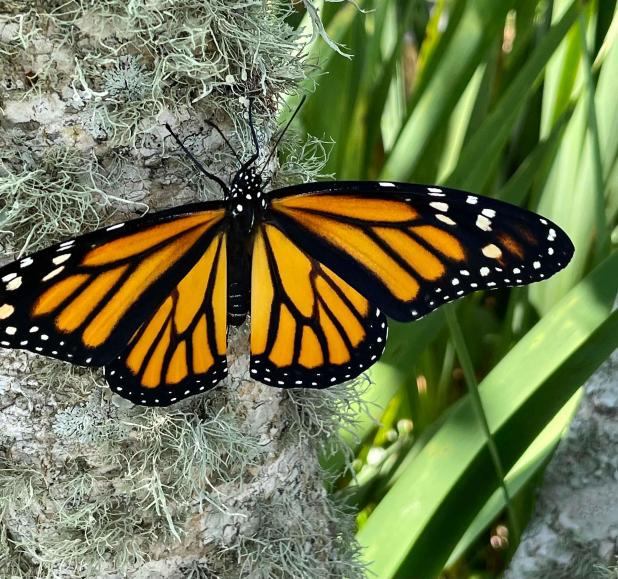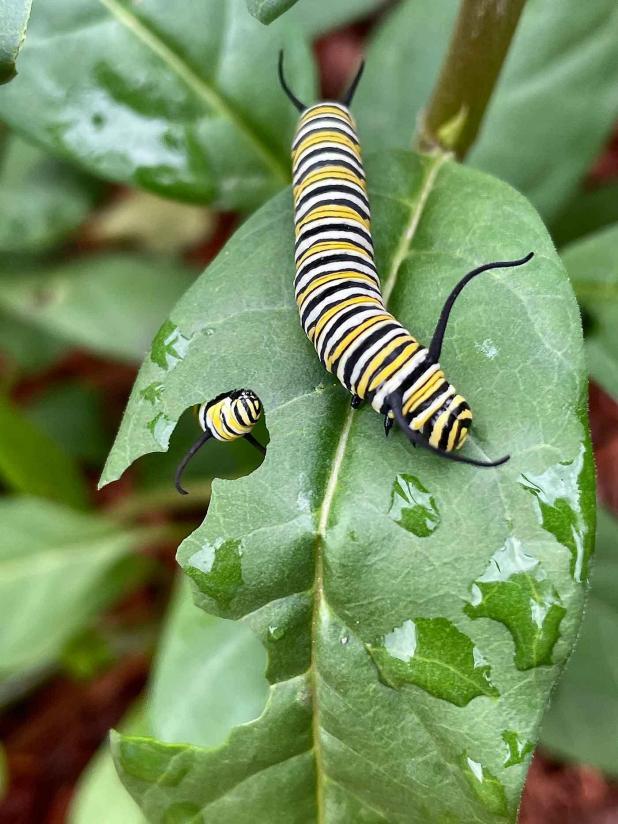
The Review/John Flores
A monarch butterfly spreads its wings in the sun.

A monarch caterpillar feeds on a tropical milk-weed plant.
John Flores: Monarch butterflies' trek can begin in your back yard
I can remember like it was yesterday when I first learned about complete and incomplete metamorphosis. What’s more, it’s been more than a half century since those fundamentals of an insect’s life became etched in my mind. I didn’t know it at the time, but they were part of the building blocks of my love for the outdoors.
As long as my wife and I have been married, she has always had a love for plants. Her passion over the years has grown into a wonderful flower garden that brings joy to those who walk through it with her.
One of her ambitions this year was to make her garden more butterfly friendly. Christine planted zinnias, firecracker flowering plants, cone flowers, lark spur, lantana, and others. Amongst them she planted “one” tropical milkweed plant and let nature take its course.
While resting one morning in the comfort of her hammock, to her delight she noticed a few tiny caterpillars on the leaves of her lone milkweed. Later she noticed a monarch butterfly with tattered and faded wings. It appeared to be using the last of its energy following its long northerly migration from Mexico to lay eggs on the leaves.
In roughly three to five days those eggs became caterpillars. In fact, so many Christine couldn’t count them all. They soon were devouring the lone tropical milkweed plant to the point it looked like a skeleton.
In a panic, Christine called around and found six more tropical milkweed plants at Marvin’s Gardens in Patterson that had just came in. While on the phone she bought them all.
A girlfriend who was shopping in Houma found two more plants at Lowes and brought them to her. Nine milkweed plants later, it appeared the caterpillars had finally had their fill.
We were out of town Easter weekend and upon returning, Christine went immediately to her butterfly garden. The caterpillars had disappeared from the plants. But, upon further investigation, she discovered light-green chrysalis everywhere.
They were attached to the shed, under the rims of flowerpots, on the wheel of one of our wheelbarrows, and even attached to the plastic of a sack of potting soil. The metamorphosis had begun.
Nola Boudreaux, a 34-year resident of Lafayette, has been raising monarchs and other species of butterflies for the past three years. Over that period, she has raised and released over 240 butterflies, mostly of which were monarchs.
Boudreaux, a high school friend who, like Christine, grew up in Bayou Vista, provided a wealth of information to glean from during the 8- to 12-day pupa stage; the stage where a larva becomes an adult.
Boudreaux said, “I started raising monarchs because of their decline in numbers and the story of their long migration journey. My first love was the black swallowtails. I discovered them by accident on parsley. I quickly learned different host plants for each species of butterflies. Soon, I had giant swallowtails, black and yellow swallowtails, monarchs, sulfur, and the special gulf fritillary butterfly, which is now our state butterfly.”
Boudreaux layers her garden by using different host plants and filling in with pollinating plants. She also provides planting pots with rims, wooden lattice, hanging planters, and garden decorations among her plants. Boudreaux keeps her butterflies in a large butterfly house, and she says these items provide monarchs a place to attach their chrysalis in a safe environment.
Essentially, those interested in raising any butterfly species will have to decide whether they want to house them or not. Boudreaux points out that people who choose to raise butterflies as a hobby must be prepared to accept there is a natural ecosystem in which they live. Most scientists agree that in the wild less than 10 percent of monarch butterflies survive from larva to adult stage.
Boudreaux said, “The strong survive, but as a butterfly hobbyist we tend to tweak their life.”
Just over a week had passed and while at work, I received a text message from Christine with a picture attached. Several of the chrysalis had changed from their light-green color to clear, where you could see the orange and black wings of a monarch butterfly. The larvae were literally hours away from escaping their cellophane-like prison and becoming adults.
Throughout the morning and into the afternoon, like a labor room nurse, nothing escaped Christine’s vigilance. She sent me videos and pictures of monarch butterflies emerging from their pupas with excitement, joy, and great wonder that she expressed in each accompanied text message.
There was a downside. Out of 18 chrysalis she counted there were three that did not emerge. Two were crushed under a pot and rolled over by accident. Apparently, monarch butterflies aren’t particular about where they locate their chrysalis, because on the wheel of a wheelbarrow is probably not a good idea.
Two emerged with crumpled wings, and one emerged with a large hole in its wing.
Scientist feel a protozoan parasite known as Ophryocystis Eleck-troscirrha infect monarch butterflies and are to blame for crumpled wings. It was just a matter of hours before the monarchs sadly expired, unable to take flight.
“This journey with butterflies has helped me emotionally to understand the beginning and end of the cycle of life,” Boudreaux reflected. “There is always a sacrifice in the journey.”
Of the 10 monarchs that did emerge healthy, they were beautiful specimens that Christine was only able to enjoy for a short period. Once their wings were dry, they took flight and departed.
The main reason for the monarch butterfly’s decline, like a lot of things, is loss of habitat. Additionally, the widespread use of Round-Up along roadsides and in agricultural fields has devastated milkweed production. Urban sprawl and continuing industrial development are also major factors in their decline.
One of the things people can do to help conserve monarch butterflies is to create small butterfly habitats in their yards.
This past week, Christine prepared and planted plenty of milkweed cuttings for next spring’s migration.
For more information about monarch butterflies and what you can do, go to monarchjointventure.org. The site has information and educational programs on how you can get involved.
